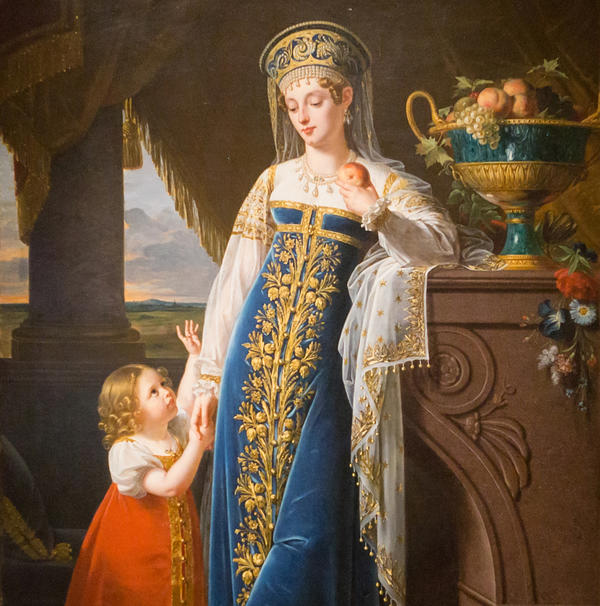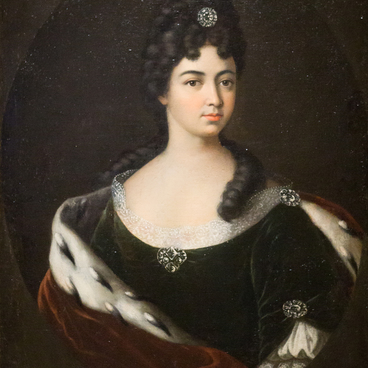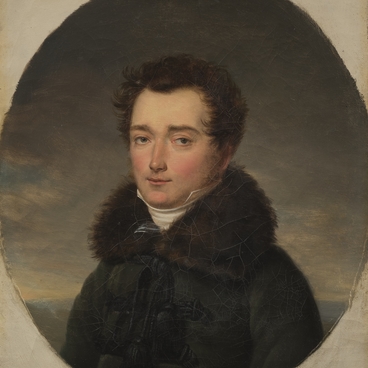The picture was painted by French artist Robert Lefèvre in 1817. He depicted Princess Maria Baryatiskaya with her 3-year old daughter Olga. The painting is an example of the classic ceremonial portrait. The genre was wide-spread in the 18th-early 19th century. The artist saw his main objective in showing a high social standing of the person.
Portrait of Baryatinskaya with her Daughter
Время создания
1817
Размер
215x150 cm
Техника
Oil on canvas
Коллекция
29
Открыть в приложении#1
Robert Lefèvre
Portrait of Baryatinskaya with her Daughter
#2
#4
Self-Portrait of Robert Lefèvre. Miniature on ivory.
img via: wikipedia.org
img via: wikipedia.org
It meant painting the model full-length on a large-size canvas. To be able to view a work like that, one had to stand at a distance. This created the impression of the subject’s might. Rich clothes, ornate entourage, stately background – all this was supposed to emphasise the high status of the model.
#6
Maria Baryatiskaya stands with her left arm resting on a granite mantelpiece. The base of the fireplace is in the shape of an animal paw. The Princess is dressed in a blue velvet gold-braided sarafan. After the victory over Napoleon in the 1812 war, the sarafan, a Russian pinafore dress, became a ceremonial court dress. On her head, she is wearing a soroka, an old-time Russian headdress worn by married women. The base of soroka is a soft canvas cap (kika) with a hard top, a band. On top of the cap, the Princess is wearing a white silk wrap with gold embroidery.
The portrait of Maria Baryatiskaya is done in the empire style, the last stage of classicism. It is characterised by references to antique art and to Renaissance. The marble column in the background and the krater-type vase with fruit refer the viewers to the time of Ancient Greece. The Princess’ posture, too, is reminiscent of an antique statue. The heavy drapery with tassels and thunderous sky in the background add solemnity to the composition. One of the artistic devices used by the empire style is a low horizon line. In painting, horizon is a visible borderline between the earth and the sky which serves the artist as a guideline to build his composition.
#10
The low horizon line in this picture gives the viewers the impression of looking at the picture bottom-up.
#8
Maria Baryatiskaya was born in 1792 to the family of Count Dorotheus Keller. He was the Prussian ambassador to Russia. At 21, Maria married diplomat Ivan Baryatinsky. Their house was one of the best known and richest in St. Petersburg. The portrait of Maria Baryatiskaya was painted for their countryside residence in Maryino in the Kursk guberniya. It was commissioned to Robert Lefèvre when the couple lived in Paris.
Maria Baryatiskaya was known for her kindness and mercy. It was for a purpose that the artist depicted her with a child as she was very fond of children. She had seven children of her own. All her children received excellent upbringing and education. In 1843, one of Maria’s daughters died from fever. In her memory, the Princess set up a shelter for poor women.
#9
Later, Maria Baryatiskaya became one of the founders of the first Russian community of nurses, the Sisters of Mercy. The Princess died in 1858, and a Russian Orthodox church of Saint Mary Magdalene was built at the place of her death.
#11
New Jerusalem Museum
читать дальшескрыть
00:00
00:00
1x
Portrait of Baryatinskaya with her Daughter
Время создания
1817
Размер
215x150 cm
Техника
Oil on canvas
Коллекция
29
Открыть в приложении
Поделиться





